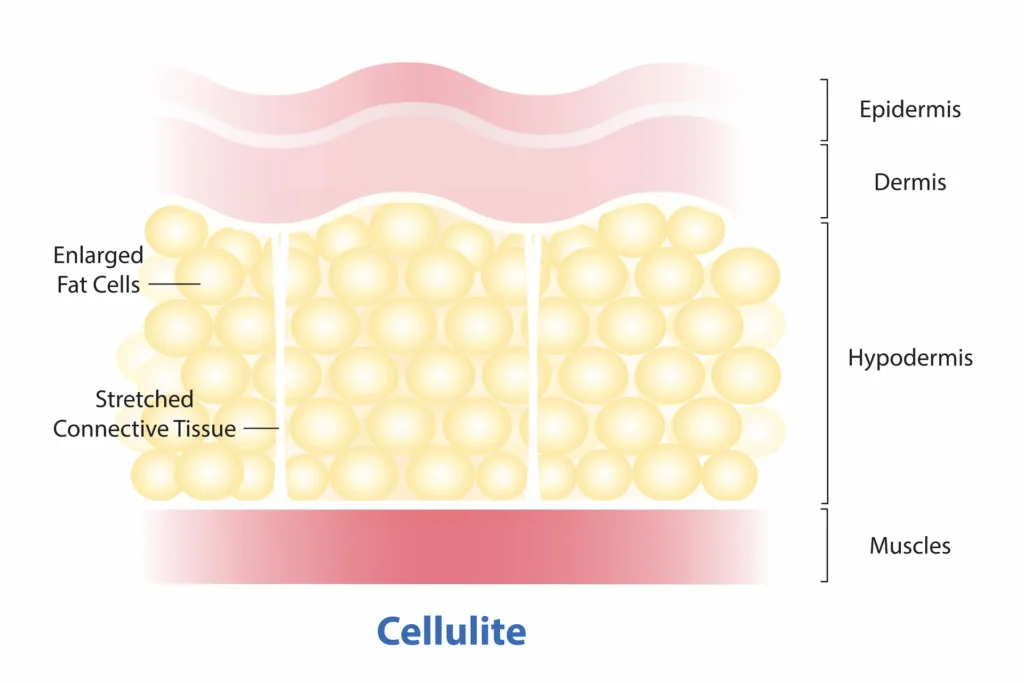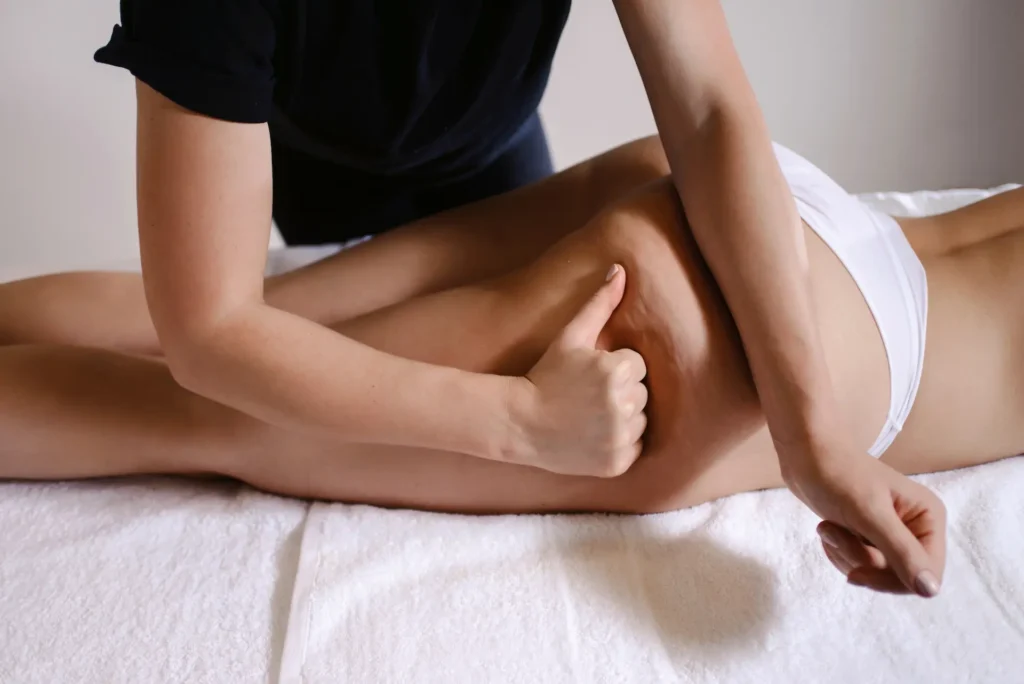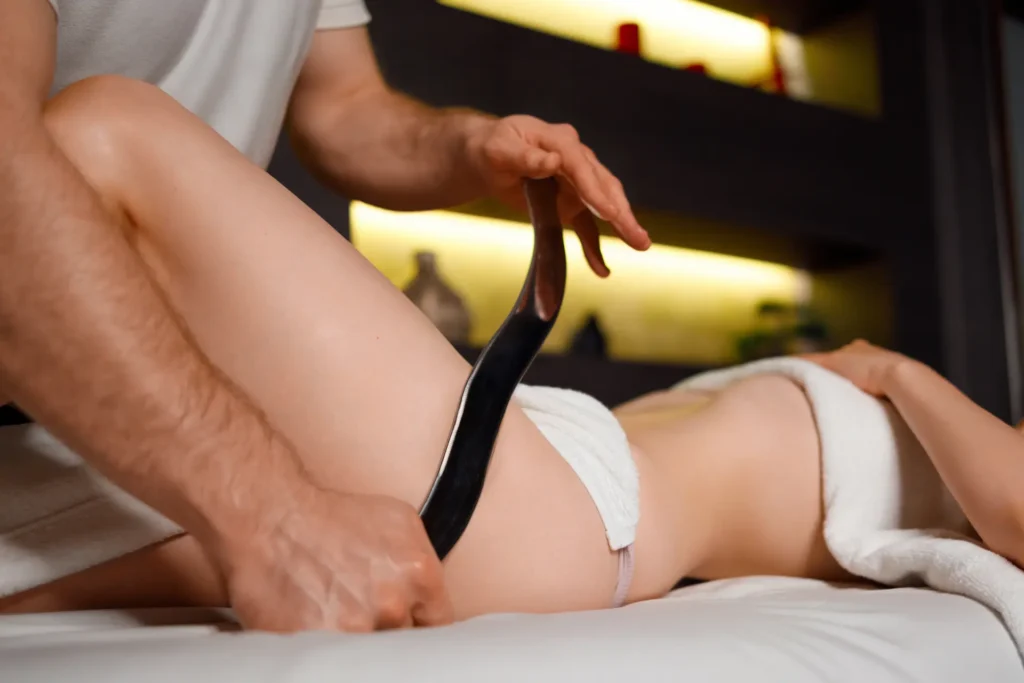You know that moment when you catch a glimpse of the back of your legs in a photo or the mirror and think, “Wait… when did that happen?”
If you’re eating well, staying active, drinking water, and still seeing cellulite, you’re not alone. And you’re not doing anything wrong. Most women—about 98%—experience it at some point, and though it’s less common, some men do too.
What many people don’t realize is that cellulite isn’t just about fat or skin. It often comes down to something underneath the surface: fascia, the connective tissue that supports everything in your body.
Once you understand how fascia works (and how bodywork helps), it becomes much easier to manage.
If you’ve never heard of fascia or didn’t realize it played a role in cellulite, check out this article on how fascia affects your whole body to learn how it impacts everything from pain to posture.
Fascia is thin, flexible connective tissue that surrounds every muscle, organ, and structure in your body. Think of it like a stretchy web or fabric holding your body in place.
When fascia is healthy and tight, it supports the tissue underneath your skin and helps it look smooth. But when fascia gets loose or restricted, especially in areas like the hips and thighs, fat cells can push through, which creates the dimples and ripples we call cellulite.
Think of it like knitted fabric. When it’s snug, it smooths everything out. When it’s stretched or worn, you start to see what’s underneath.

Hormones, anatomy, and biology all play a role here. Here’s why women tend to see more cellulite than men:
That’s why even women who are lean, active, and strong can still have cellulite. It’s not always about how much fat you have. It’s often about how your fascia is supporting (or not supporting) that tissue.
Want a deeper look at the common causes of cellulite? We cover it in this article on cellulite treatment and prevention.

At Bodywork Masters, we’ve seen how massage and focused bodywork can make a real difference in reducing the appearance of cellulite.
We don’t make big, flashy promises. We just focus on treating the actual cause—unhealthy fascia.
Our work helps to:
We also use heated tools to warm up the area and improve results. Heat helps fascia release more easily, and it boosts circulation in stubborn areas like the thighs and glutes where cellulite often shows up. It’s a newer approach that we’ve been trying, and it’s shown some great results.
Over time, all of this helps the skin lay flatter and smoother.

We’re not throwing the whole toolbox at cellulite, just the tools that actually work for this kind of issue. Here are the most relevant bodywork techniques we use in our practice to help manage cellulite:
This technique focuses on softening areas where fascia has become tight or stuck. When that happens, it can pull on the skin and cause that uneven, dimpled look. Myofascial Release helps relax those areas, making the skin look smoother and helping the layers underneath move more freely.
Depending on the area, we may use our hands, a tool, or even heat. It feels a bit like a deep stretch or a slow, steady massage, comfortable and effective.
Cupping uses gentle suction to lift the fascia and muscle layers, bringing fresh blood flow into areas that may be stuck or slow to move. It also supports lymphatic drainage, which helps reduce puffiness and clear out built-up waste in the tissue.
We often use glute cupping to focus on the butt and outer thighs, where cellulite tends to show up most. It’s not only effective, it feels like a mix between a massage and a stretch. Clients love the results and the feeling.
This technique uses smooth-edged tools to gently scrape along the skin. It sounds more intense than it is. In reality, Gua Sha feels a lot like a firm massage, and it’s great for helping tight fascia loosen up and move more easily.
Many clients notice their skin feels smoother and their legs or hips move more freely after just one session.
Even stretching can help with cellulite when it’s done right. During an assisted stretching session, we gently guide your body through movements that open up the hips, legs, and glutes. This helps fascia relax, improves posture, and keeps the tissue from bunching up.
Stretching this way is a great follow-up to massage or any of the bodywork techniques we use.
One of our clients, Lisa, came in feeling frustrated. She exercised regularly, ate well, and still had cellulite that bothered her. After a few sessions that focused on the hips, thighs, and glutes, she started to see and feel a real change.
It wasn’t just about how her skin looked, though her jeans did fit better. It was how she felt. She had less tension in her lower body, better movement, and even improved circulation.
Her fascia had been tight and restricting movement without her even knowing it. That tension was causing her discomfort, but once we worked with the tissue, everything changed.

Bodywork is powerful, but it works even better when paired with healthy daily habits. Here are some simple ways to keep your fascia happy between sessions:
These habits won’t erase cellulite overnight, but they will support everything we do during your sessions and help maintain results.
Just a reminder: cellulite is completely normal. But if it’s making you uncomfortable or affecting how your body feels, massage and bodywork can help you address it from the inside out, in a natural and supportive way.
No gimmicks, no harsh treatments. Just skilled hands, targeted techniques, and a plan that’s tailored to your body.

If you’re curious about how massage and bodywork can help reduce cellulite, improve movement, and support your fascia, we’d love to work with you.
Reach out today to schedule your session. Whether you’re brand new or returning for more, we’ll help you create a plan that feels good and gets results you can feel and see.